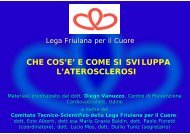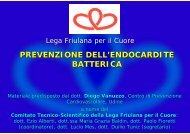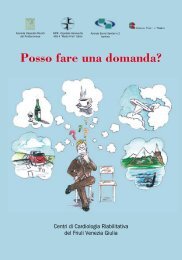Che cosa sono le dislipidemie e come si possono curare
Che cosa sono le dislipidemie e come si possono curare
Che cosa sono le dislipidemie e come si possono curare
Create successful ePaper yourself
Turn your PDF publications into a flip-book with our unique Google optimized e-Paper software.
LIPOPROTEIN-<br />
LIPASI<br />
INTESTINO<br />
1<br />
chilomicroni<br />
acidi gras<strong>si</strong><br />
liberi<br />
HDL<br />
2<br />
gras<strong>si</strong> alimentari<br />
re<strong>si</strong>dui<br />
3<br />
VLDL<br />
4<br />
FEGATO<br />
COLECISTI<br />
IDL<br />
7<br />
5<br />
6<br />
LDL<br />
RECETTORI LDL<br />
TESSUTI<br />
ARTERIA<br />
1, l’intestino produce chilomicroni; 2, la lipoproteinlipa<strong>si</strong> scinde i chilomicroni in re<strong>si</strong>dui, captati<br />
dal fegato e acidi gras<strong>si</strong> liberi; 3, il fegato produce VLDL; 4: dal<strong>le</strong> VLDL al<strong>le</strong> IDL; 5, dal<strong>le</strong> IDL al<strong>le</strong> LDL; 6, <strong>le</strong> LDL<br />
dopo il contatto coi tessuti <strong>sono</strong> captate dai recettori del fegato, ma se in eccesso <strong>si</strong> depo<strong>si</strong>tano nel<strong>le</strong> arterie; 7, il<br />
co<strong>le</strong>sterolo HDL opera il trasporto inverso del co<strong>le</strong>sterolo dai tessuti al fegato.







